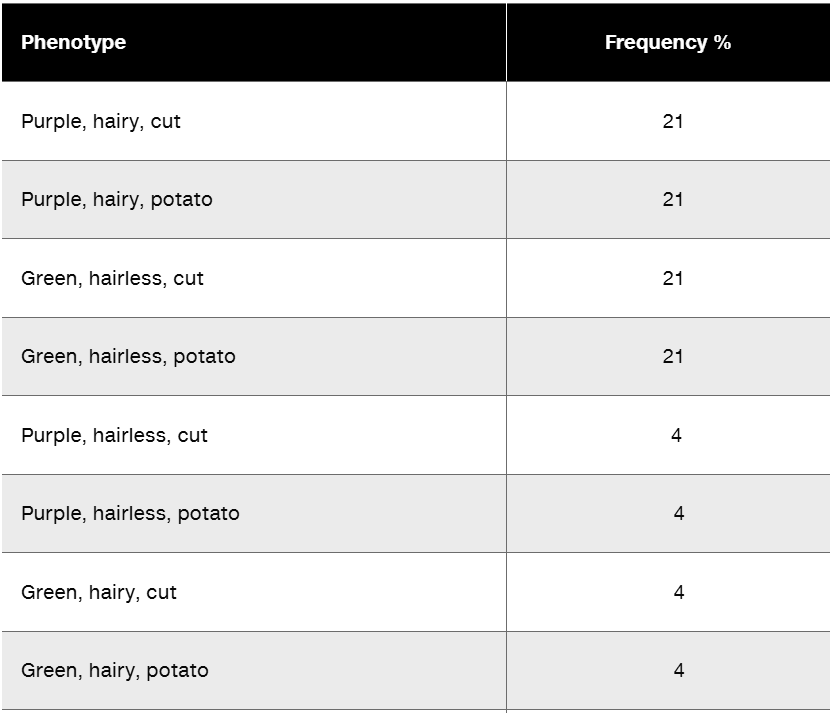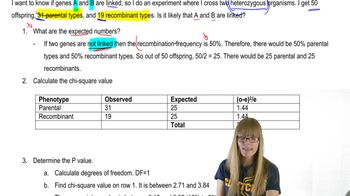Which of the following gametes cannot be formed from the genotype DDeeFfGG?
Table of contents
- 1. Introduction to Genetics51m
- 2. Mendel's Laws of Inheritance3h 37m
- 3. Extensions to Mendelian Inheritance2h 41m
- 4. Genetic Mapping and Linkage2h 28m
- 5. Genetics of Bacteria and Viruses1h 21m
- 6. Chromosomal Variation1h 48m
- 7. DNA and Chromosome Structure56m
- 8. DNA Replication1h 10m
- 9. Mitosis and Meiosis1h 34m
- 10. Transcription1h 0m
- 11. Translation58m
- 12. Gene Regulation in Prokaryotes1h 19m
- 13. Gene Regulation in Eukaryotes44m
- 14. Genetic Control of Development44m
- 15. Genomes and Genomics1h 50m
- 16. Transposable Elements47m
- 17. Mutation, Repair, and Recombination1h 6m
- 18. Molecular Genetic Tools19m
- 19. Cancer Genetics29m
- 20. Quantitative Genetics1h 26m
- 21. Population Genetics50m
- 22. Evolutionary Genetics29m
3. Extensions to Mendelian Inheritance
Understanding Independent Assortment
Problem 5b
Textbook Question
In tomato plants, purple leaf color is controlled by a dominant allele A, and green leaf by a recessive allele a. At another locus, hairy leaf H is dominant to hairless leaf h. The genes for leaf color and leaf texture are separated by 16 m.u. on chromosome 5. On chromosome 4, a gene controlling leaf shape has two alleles: a dominant allele C that produces cut-leaf shape and a recessive allele c that produces potato-shaped leaves.

Fully explain the number and frequency of each phenotype class.
 Verified step by step guidance
Verified step by step guidance1
Understand the genetic basis of the problem: There are three loci involved in this problem. The first locus (A/a) determines leaf color, the second locus (H/h) determines leaf texture, and the third locus (C/c) determines leaf shape. The genes A/a and H/h are linked on chromosome 5, separated by 16 map units (m.u.), while the gene C/c is on a separate chromosome (chromosome 4) and thus independently assorting.
Determine the possible gametes for the linked genes (A/a and H/h): Since these genes are 16 m.u. apart, there is a 16% chance of recombination between them. This means that 84% of the gametes will be parental (AH and ah if the parent is heterozygous) and 16% will be recombinant (Ah and aH). Calculate the frequencies of each gamete type based on this information.
Determine the possible gametes for the independently assorting gene (C/c): Since this gene is on a different chromosome, it will assort independently. If the parent is heterozygous (C/c), the gametes will be produced in equal frequencies (50% C and 50% c). Combine these with the gametes from the linked genes to determine all possible gamete combinations.
Use a Punnett square or probability rules to determine the genotypes of the offspring: Cross the gametes from both parents to determine the genotypic combinations of the offspring. For the linked genes, account for the recombination frequencies, and for the independently assorting gene, use standard Mendelian ratios.
Determine the phenotypes and their frequencies: Translate the genotypes into phenotypes based on the dominance relationships (A = purple, a = green; H = hairy, h = hairless; C = cut-leaf, c = potato-shaped). Combine the probabilities from the linked genes and the independently assorting gene to calculate the overall frequency of each phenotype class.
 Verified video answer for a similar problem:
Verified video answer for a similar problem:This video solution was recommended by our tutors as helpful for the problem above
Video duration:
2mPlay a video:
Was this helpful?
Key Concepts
Here are the essential concepts you must grasp in order to answer the question correctly.
Mendelian Genetics
Mendelian genetics is the study of how traits are inherited through generations based on the principles established by Gregor Mendel. It involves understanding dominant and recessive alleles, where dominant alleles mask the expression of recessive ones. This framework helps predict the phenotypic ratios of offspring based on parental genotypes, which is essential for analyzing the phenotypes of the tomato plants in the question.
Recommended video:
Guided course

Descriptive Genetics
Linkage and Recombination
Linkage refers to the tendency of genes located close to each other on the same chromosome to be inherited together. The concept of recombination describes how chromosomes can exchange segments during meiosis, leading to new allele combinations. The mention of genes being separated by 16 m.u. indicates their distance on the chromosome, which affects the frequency of recombination and ultimately influences the phenotype ratios in the offspring.
Recommended video:
Guided course

Chi Square and Linkage
Phenotypic Ratios
Phenotypic ratios represent the relative frequencies of different observable traits in the offspring resulting from genetic crosses. In this scenario, the phenotypes of the tomato plants are determined by the combinations of alleles for leaf color, texture, and shape. Understanding how to calculate these ratios based on the inheritance patterns and linkage of the alleles is crucial for fully explaining the number and frequency of each phenotype class.
Recommended video:
Guided course

Mutations and Phenotypes

 4:58m
4:58mWatch next
Master Gamete Genetics and Independent Assortment with a bite sized video explanation from Kylia
Start learningRelated Videos
Related Practice
Multiple Choice
747
views
2
rank
